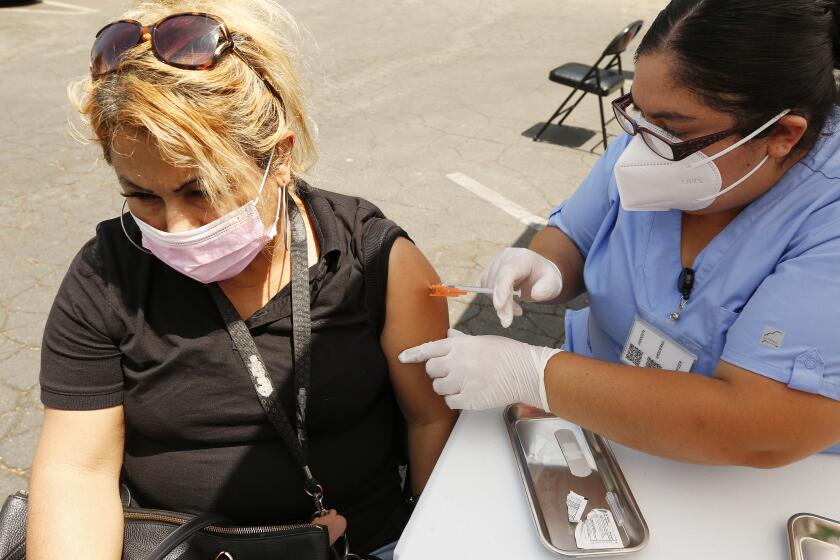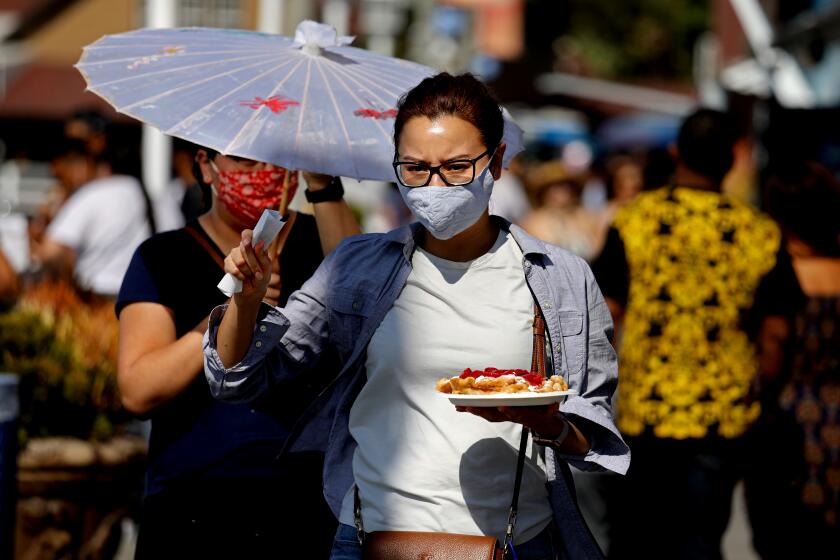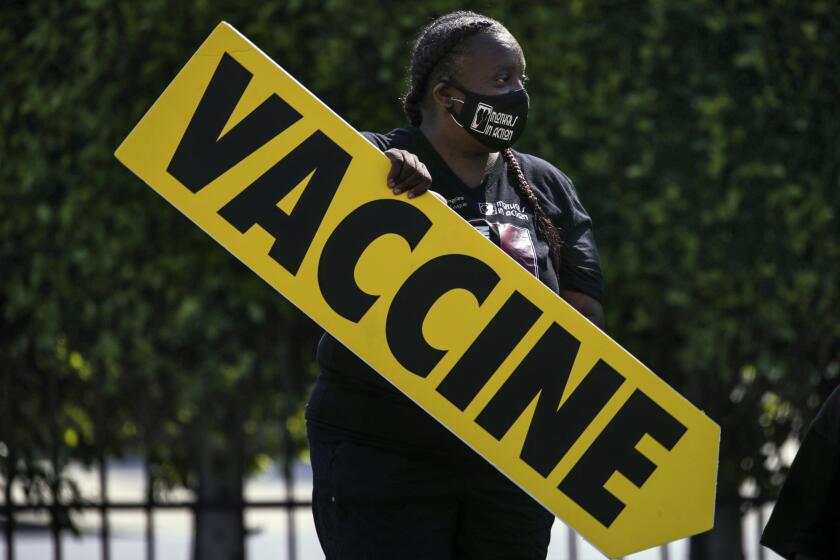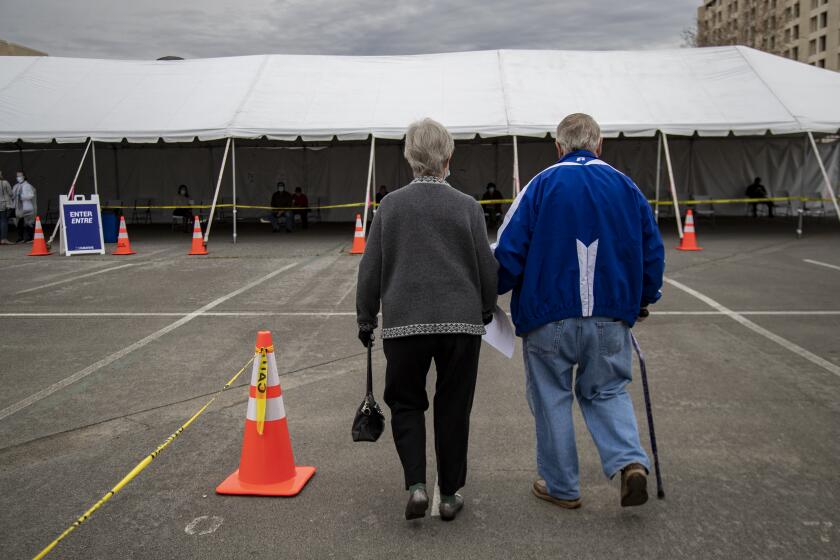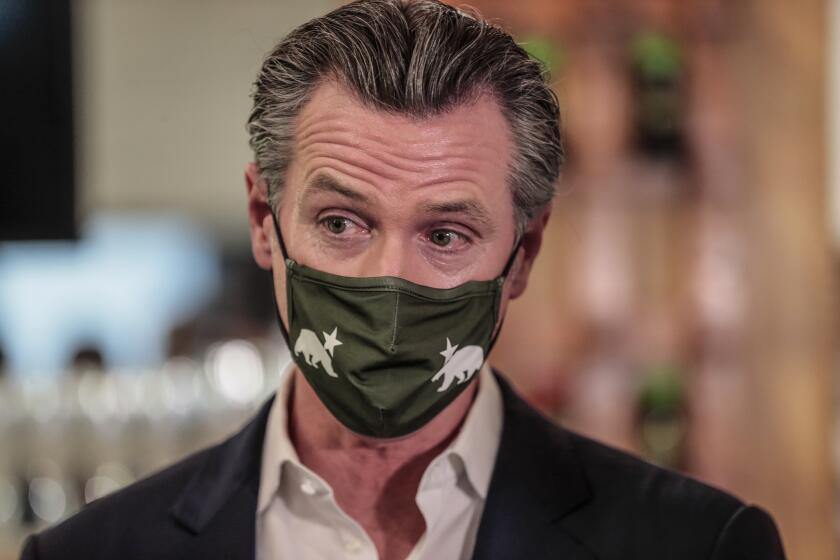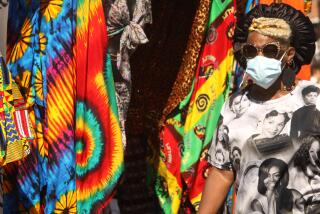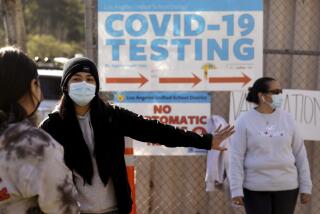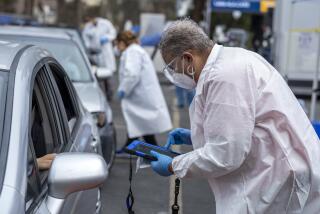California government, health workers must show proof of vaccination or be tested regularly

California will require state employees and all healthcare workers to show proof of a COVID-19 vaccination or get tested weekly, tightening restrictions in an effort to slow rising coronavirus infections in the nation’s most populous state, mostly among the unvaccinated.
- Share via
California state and healthcare employees will soon be required to show proof they’ve been vaccinated against COVID-19, with those who remain uninoculated subject to a regular testing regimen, as part of growing national effort to use such screenings in hopes of slowing a new coronavirus surge.
The action comes as institutions ranging from cities to some private businesses and the federal Veterans Administration move to check employee vaccination status in hopes of blunting the spread of the highly contagious Delta variant without returning to the restrictions seen earlier in the pandemic.
The new California guidance is not a vaccine mandate, the likes of which have been announced for municipal workers in some areas of the state, but effectively removes the “honor system” in which some workers were able to self-attest to their vaccination status.
When the additional requirements are in place, state employees who are unvaccinated, or decline to provide proof of vaccination, will be tested for coronavirus infection at least once a week, according to the California Department of Human Resources.
“Unvaccinated employees will continue to be required to wear a mask indoors until they are vaccinated,” the department added in a statement.
There are roughly 246,000 state employees, Gov. Gavin Newsom said Monday.
Healthcare facilities in both the private and public sectors — as well as congregate settings such as jails, homeless shelters and senior living homes — will be subject to similar requirements, and any unvaccinated employees will have to wear appropriate personal protective equipment, such as masks.
Those who work in high-risk settings, such as acute care and skilled nursing facilities, will need to be tested twice a week if they don’t provide proof of vaccination, Newsom said.
State officials are encouraging all employers to consider adopting similar standards.
For state workers, the new policy will start Aug. 2, with testing “phased in over the next few weeks,” according to a statement from Newsom’s office.
The effective date is Aug. 9 for healthcare and congregate workers. Healthcare facilities will need to come into compliance by Aug. 23.
“Too many people have chosen to live with this virus,” Newsom told reporters Monday. “We’re at a point in this epidemic, this pandemic, where choice — individuals’ choice not to get vaccinated — is now impacting the rest of us in a profound and devastating and deadly way.”
The announcement comes as California continues to see rapid increases in COVID-19 cases and hospitalizations, with the overwhelming bulk of new infection and illness taking place among the uninoculated.
According to the California Health and Human Services Agency, the latest coronavirus case rate among unvaccinated residents is thought to be above 14 per 100,000 people — roughly seven times the rate for those who are fully vaccinated.
Over the weeklong period ending Sunday, California reported an average of 5,800 new coronavirus cases a day, according to data compiled by The Times.
That’s six times the rate seen a month ago — though still only a fraction of the massive infection counts seen during the fall and winter surge, when the state was recording more than 40,000 daily cases on average.
Hospitalizations, too, have ballooned in recent weeks. On Sunday, 2,981 coronavirus-positive patients were hospitalized statewide, with 669 of them in intensive care, state data show.
Both those figures have more than doubled over the last month.
COVID-19 deaths, however, remain relatively low, at about 22 a day statewide.
L.A. County hit 3,000 new coronavirus cases Friday as the surge fueled by the Delta variant worsened.
While Monday’s announcement by Newsom is short of a vaccination mandate, some other areas of the state, including San Francisco and Pasadena, have already said they will require city workers to be inoculated once the federal government approves the vaccines beyond their current emergency use. The University of California system also announced it would require vaccines for all students, faculty and others for the fall term.
It’s not just California, either. New York City is going to require city workers to be vaccinated or submit to regular testing. And on Monday, the federal Department of Veterans Affairs said it would require healthcare workers to be vaccinated against COVID-19, the first federal agency to make such a mandate.
Los Angeles has yet to announce any similar requirement for its employees. But some L.A. City Council members have come out in favor of the idea.
“The Delta variant has clearly proven that the unvaccinated community are deeply vulnerable, and they’ve put their lives in jeopardy ... not just their lives, but the lives of their co-workers, family and neighbors,” Councilman Kevin de León said Monday.
Mayor Eric Garcetti “has been working urgently with city stakeholders toward policy changes to increase the employee vaccination rate and make the workplace safer for everyone,” his spokesman, Alex Comisar, said Monday. “He will be discussing this in more detail very soon.”
In San Bernardino, a pop-up vaccine clinic in a McDonald’s parking lot attracts fewer than two dozen people to get shots, a snapshot of the faltering effort.
Ahead of the state’s June 15 reopening, some officials were candid that removing the guardrails that had long defined California’s pandemic response — including widespread mask mandates, capacity restrictions, and requirements for physical distancing in businesses and venues — could lead to some increase in community transmission.
But even expected trends can play out in unexpected ways.
Enter the Delta variant: a particularly problematic mutation believed to be twice as transmissible as the conventional coronavirus strains.
Its presence was first confirmed in California in April, and it has since become the most dominant variant circulating statewide.
Coronavirus infections in Los Angeles County are accelerating amid a surge that has cases and hospitalizations reaching levels not seen in months.
According to the latest data released by the California Department of Public Health, 82.8% of coronavirus cases analyzed in July have been identified as the Delta variant, up from 52.8% in June.
While only a relative smattering of infections are analyzed to detect the responsible variants, officials say the rapidly increasing share of cases that are coming up Delta indicate that the variant is spreading widely.
Given the recent resurgence of the coronavirus, and in light of the continued circulation of the Delta variant, a number of California counties are urging all residents — regardless of vaccination status — to wear masks while in indoor public places as a precaution.
Los Angeles County has gone a step further and is now mandating the practice. The county reported 1,966 new cases on Monday alone.
“We need the additional protection while more individuals get vaccinated if we want to get back to low rates of transmission,” county Public Health Director Barbara Ferrer said in a statement.
In June, 20% of Los Angeles County’s coronavirus cases were among fully vaccinated residents. But that doesn’t tell the full story.
Health officials say fully vaccinated people remain well protected, especially against severe COVID-19 disease. And there’s optimism in some circles that the latest surge won’t trigger the same sort of resulting rises in hospitalizations and deaths that caused so much heartbreak over the winter.
But there’s also real concern that the Delta variant could wreak havoc on the still-substantial slice of California that has yet to be inoculated.
Overall, more than 60% of Californians have now gotten at least one dose, and nearly 53% are fully vaccinated, according to data compiled by The Times.
But the state — like the rest of the country — has seen a dramatic drop-off in its inoculation pace since the spring.
At the height of the rollout in April, providers statewide were administering about 400,000 shots a day, on average. But California hasn’t cracked 100,000 new daily doses for a month.
One reason for the slowdown is mathematical. With a good number of people already vaccinated, and with children younger than 12 still not yet eligible, the pool of people who can roll up their sleeves has shrunk dramatically over the past several months.
It used to be hard to find a vaccine appointment. Not any more. Here’s how to get your COVID-19 shot.
But officials say there’s also a share of the population who are either adamantly opposed to getting vaccinated, or have other issues that have so far kept them from doing so.
The vaccine campaign, like many facets of the nation’s COVID-19 response, has also been fertile ground for disinformation and conspiracy theories.
Newsom didn’t mince words on that front Monday, saying, “We’re exhausted by the politicization of this pandemic” and “it needs to be called out.”
“It’s [a] choice to live with this virus. And, with all due respect, you don’t have a choice to go out and drink and drive and put everybody else’s lives at risk,” he said. “That’s the equivalent of this moment with the deadliness and efficiency of the Delta virus. You’re putting other people’s, innocent people’s, lives at risk.”
Newsom did not directly answer a question during a news conference in Sonoma County when asked about the possibility of a statewide indoor mask mandate.
The latest rise in COVID-19 cases also puts Newsom in an uncomfortable political position.
Proponents of recalling the governor have criticized the sweeping statewide orders and business restrictions the governor imposed last year in an effort to slow the spread of the virus. With the recall election just two months away, ordering new restrictions could risk frustrating some California voters all over again.
Although California retired its color-coded tiered reopening system last month, more than a dozen counties, including Los Angeles and Riverside, now exceed the threshold that would have placed them in the state’s most restrictive purple tier. Under the old framework, counties in that category had to suspend or severely limit indoor operations across a wide swath of business sectors.
To this point, Newsom has also appeared reluctant to reinstate statewide mask orders as many counties either require people to wear them or ask for voluntary compliance in indoor spaces.
When asked about the possibility, including again on Monday, Newsom has consistently said such measures won’t be necessary if more people get vaccinated.
“I encourage folks to get vaccinated,” he said. “That’s our focus.”
More to Read
Sign up for Essential California
The most important California stories and recommendations in your inbox every morning.
You may occasionally receive promotional content from the Los Angeles Times.
